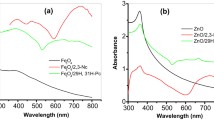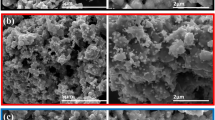Abstract
Integrating other metal ions into mono-metallic metal–organic framework (MOF) to form bi-metallic MOF is an effective strategy to enhance the performance of MOFs from the internal structure. In this study, two-dimensional (2D) cobalt/zinc-porphyrin (Co/Zn-TCPP) MOF nanomaterials with different Co/Zn molar ratios were synthesised using a simple surfactant-assisted method, and novel dopamine (DA) sensing methods were constructed based on these materials. The characterisation results showed that all MOF with different Co/Zn molar ratios presented a nanofilm, and the Co and Zn elements were uniformly distributed. All sensors based on CoxZn100−x-TCPP had a certain catalytic performance to DA. Among them, the sensor based on CO25Zn75-TCPP showed the strongest signal response, indicating that the catalytic performance of MOF on DA can be adjusted by changing the Co/Zn molar ratio. The doping of metal ions improves the chemical environment of the pores, and increases the types and spatial arrangement of the active sites of the MOF, which is beneficial to the electron transfer and exchange with DA; Co2+ and Zn2+ active centres have a synergistic promotion effect, so the catalytic activity of MOF is significantly improved. The linear range at the potential of 0.1 V based on Co25Zn75-TCPP for DA was 5 nM–177.8 μM, with a detection limit of 1.67 nM (S/N = 3). The sensor exhibited a good selectivity for detecting DA. This research is expected to provide new ideas and references for constructing high-performance sensing interfaces and platforms.
Graphical abstract









Similar content being viewed by others
References
Yu XY, Yu L, Wu HB, Lou XW (2015) Formation of nickel sulfide nanoframes from metal–organic frameworks with enhanced pseudocapacitive and electrocatalytic properties. Angew Chem 127:5421–5425
Ma J, Chen G, Bai W, Zheng J (2020) Amplified electrochemical hydrogen peroxide sensing based on Cu-porphyrin metal–organic framework nanofilm and G–quadruplex–hemin DNAzyme. ACS Appl Mater Interfaces 12:58105–58112
Wang B, Zhao M, Li L, Huang Y, Zhang X, Guo C, Zhang Z, Cheng H, Liu W, Shang J, Jin J, Sun X, Liu J, Zhang H (2020) Ultra–thin metal–organic framework nanoribbons. Natl Sci Rev 7:46–52
Bai W, Li S, Ma J, Cao W, Zheng J (2019) Ultrathin 2D metal–organic framework (nanosheets and nanofilms) –based xD–2D hybrid nanostructures as biomimetic enzymes and supercapacitors. J Am Chem Soc 7:9086–9098
Liu W, Yin XB (2016) Metal–organic frameworks for electrochemical applications, Trac-Trends. Anal Chem 75:86–96
Masoomi MY, Morsali A, Dhakshinamoorthy A, Garcia H (2019) Mixed–metal MOFs: unique opportunities in metal–organic framework (MOF) functionality and design. Angew Chem 58:15188–15205
Queen WL, Hudson MR, Bloch ED, Mason JA, Gonzalez MI, Lee JS, Gygi D, Howe JD, Lee K, Darwish TA, James M, Peterson VK, Teat SJ, Smit B, Neaton JB, Long JR, Brown CM (2014) Comprehensive study of carbon dioxide adsorption in the metal–organic frameworks M2(dobdc) (M=Mg, Mn, Fe Co, Ni, Cu, Zn). Chem Sci 5:4569
Niu X, Li X, Lyu Z, Pan J, Ding S, Ruan X, Zhu W, Du D, Lin Y (2020) Metal–organic framework based nanozymes: promising materials for biochemical analysis. Chem Commun 56:11338–11353
Fu Y, Xu L, Shen H, Yang H, Zhang F, Zhu W, Fan M (2016) Tunable catalytic properties of multi–metal–organic frameworks for aerobic styrene oxidation. Chem Commun 299:135–141
Kaur G, Rai RK, Tyagi D, Yao X, Li PZ, Yang XC, Zhao YL, Xu Q, Singh SK (2016) Room–temperature synthesis of bimetallic Co–Zn based zeolitic imidazolate frameworks in water for enhanced CO2 and H2 uptakes. J Mater Chem A 4:14932
Ji L, Jin Y, Wu K, Wan C, Yang N, Tang Y (2018) Morphology–dependent electrochemical sensing performance of metal (Ni Co, Zn) –organic frameworks. Anal Chim Acta 1031:60–66
Ketrat S, Maihom T, Wannakao S, Probst M, Nokbin S, Limtrakul J (2017) Coordinatively unsaturated metal–organic frameworks M3(btc)2 (M = Cr, Fe Co, Ni, Cu, and Zn) catalyzing the oxidation of CO by N2O: insight from DFT calculations. Inorg Chem 56:14005–14012
Li R, Ren X, Ma H, Feng X, Lin Z, Li X, Hu C, Wang B (2014) Nickel–substituted zeolitic imidazolate frameworks for time–resolved alcohol sensing and photocatalysis under visible light. J Mater Chem A 2:5724–5729
Jiang ZW, Zou YC, Zhao TT, Zhen SJ, Li YF, Huang CZ (2020) Controllable synthesis of porphyrin–based 2D lanthanide metal–organic frameworks with thickness– and metal–node–dependent photocatalytic performance. Angew Chem 132:3326–3332
Zhu W, Yang Y, Jin Q, Chao Y, Tian L, Liu J, Dong Z, Liu Z (2019) Two–dimensional metal–organic–framework as a unique theranostic nano–platform for nuclear imaging and chemo-photodynamic cancer therapy. Nano Res 12:1307–1312
Chen J, Lin S, Zhao D, Guan L, Hu Y, Wang Y, Lin K, Zhu Y (2020) Palladium nanocrystals–engineered metal–organic frameworks for enhanced tumor inhibition by synergistic hydrogen/photodynamic therapy. Adv Funct Mater 31:2006853
Khan AF, Brownson DA, Randviir EP, Smith GC, Banks CE (2016) 2D Hexagonal Boron Nitride (2D–hBN) Explored for the electrochemical sensing of dopamine. Anal Chem 88:9729–9737
Zhang W, Liu L, Li Y, Wang D, Ma H, Ren H, Shi Y, Han Y, Ye B (2018) Electrochemical sensing platform based on the biomass–derived microporous carbons for simultaneous determination of ascorbic acid, dopamine, and uric acid. Biosens Bioelectron 121:96–103
Kavanagh DJ, Andrade J, May J (2005) Imaginary relish and exquisite torture: the elaborated intrusion theory of desire. Psychol Rev 112:446–467
Franken IHA, Booij J, van den Brink W (2005) The role of dopamine in human addiction: from reward to motivated attention. Eur J Pharmacol 526:199–206
Beaulieu JM, Gainetdinov RR (2011) The physiology, signaling, and pharmacology of dopamine receptors. Pharmacol Rev 63:182–217
Berke JD, Hyman SE (2000) addiction, dopamine, and the molecular mechanisms of memory. Neuron 25:515–532
Ramachandran A, Panda S, Yesodha SK (2018) Physiological level and selective electrochemical sensing of dopamine by a solution processable graphene and its enhanced sensing property in general. Sens Actuators B Chem 256:488–497
Ramakrishnan S, Pradeep KR, Raghul A, Senthilkumar R, Rangarajan M, Kothurkar NK (2015) One-step synthesis of Pt-decorated graphene–carbon nanotubes for the electrochemical sensing of dopamine, uric acid and ascorbic acid. Anal Methods 7:779–786
Zhao M, Li Z, Zhang X, Yu J, Ding Y, Li H, Ma Y (2020) Employing the interfacial barrier of P–rGO/ZnO microspheres for improving the electrochemical sensing performance to dopamine Sens. Actuators B Chem 309:127757
Yang H, Zhao J, Qiu M, Sun P, Han D, Niu L, Cui G (2019) Hierarchical bi-continuous Pt decorated nanoporous Au–Sn alloy on carbon fiber paper for ascorbic acid, dopamine and uric acid simultaneous sensing. Biosens Bioelectron 124:191–198
Sha T, Li X, Liu J, Sun M, Wang N, Bo X, Guo Y, Hu Z, Zhou M (2018) Biomass waste derived carbon nanoballs aggregation networks-based aerogels as electrode material for electrochemical sensing. Sens Actuators B Chem 277:195–204
Xue C, Han Q, Wang Y, Wu J, Wen T, Wang R, Hong J, Zhou X, Jiang H (2013) Amperometric detection of dopamine in human serum by electrochemical sensor based on gold nanoparticles doped molecularly imprinted polymers. Biosens Bioelectron 49:199–203
Song Y, Han J, Xu L, Miao L, Peng C, Wang L (2019) A dopamine–imprinted chitosan film/porous ZnO NPs@carbon nanospheres/macroporous carbon for electrochemical sensing dopamine sens. Actuators B Chem 298:126949
Bas SZ, Cummins C, Selkirk A, Borah D, Ozmen M, Morris MA (2019) A novel electrochemical sensor based on metal ion infiltrated block copolymer thin films for sensitive and selective determination of dopamine. ACS Appl Nano Mater 2:7311–7318
Ma J, Bai W, Zheng J (2019) Non-enzymatic electrochemical hydrogen peroxide sensing using a nanocomposite prepared from silver nanoparticles and copper (II) –porphyrin derived metal–organic framework nanosheets. Microchim Acta 186:482
Ma J, Zheng J (2020) Voltammetric determination of hydrogen peroxide using AuCu nanoparticles attached on polypyrrole–modified 2D metal–organic framework nanosheets. Microchim Acta 187:389
Wang Y, Zhao M, Ping J, Chen B, Cao X, Huang Y, Tan C, Ma Q, Wu S, Yu Y, Lu Q, Chen J, Zhao W, Ying Y, Zhang H (2016) Bioinspired design of ultrathin 2D bimetallic metal–organic-framework nanosheets used as biomimetic enzymes. Adv Mater 28:4149–4155
Xie F, Cao X, Qu F, Asiri AM, Sun X (2018) Cobalt nitride nanowire array as an efficient electrochemical sensor for glucose and H2O2 detection. Sens Actuators B Chem 255:1254–1261
Ye L, Gao Y, Cao S, Chen H, Yao Y, Hou J, Sun L (2018) Assembly of highly efficient photocatalytic CO2 conversion systems with ultrathin two-dimensional metal–organic framework nanosheets. Appl Catal B-Environ 227:54–60
Zhang P, Zhang L, Zhao G, Feng F (2012) A highly sensitive nonenzymatic glucose sensor based on CuO nanowires. Microchim Acta 176:411–417
Cui HF, Ye JS, Zhang WD, Li CM, Luong JHT, Sheu FS (2007) Selective and sensitive electrochemical detection of glucose in neutral solution using platinum–lead alloy nanoparticle carbon nanotube nanocomposites. Anal Chim Acta 594:175–183
Huang Q, Lin X, Tong L, Tong QX (2020) graphene quantum dots/multiwalled carbon nanotubes composite-based electrochemical sensor for detecting dopamine release from living cells. ACS Sustainable Chem Eng 8:1644–1650
Kumar M, Swamy BEK, Reddy S, Zhao W, Chetana S, Kumar VG (2019) ZnO/functionalized MWCNT and Ag/functionalized MWCNT modified carbon paste electrodes for the determination of dopamine, paracetamol and folic acid. J Electroanal Chem 835:96–105
Rajaei M, Foroughi MM, Jahani S, Zandi MS, Nadiki HH (2019) Sensitive detection of morphine in the presence of dopamine with La3+ doped fern-like CuO nanoleaves/MWCNTs modified carbon paste electrode. J Mol Liq 284:462–472
Zou J, Wu S, Liu Y, Sun Y, Cao Y, Hsu JP, Wee ATS, Jiang J (2018) An ultra-sensitive electrochemical sensor based on 2D g-C3N4/CuO nanocomposites for dopamine detection. Carbon 130:652–663
Shu Y, Li Z, Yang Y, Tan J, Liu Z, Shi Y, Ye C, Gao Q (2021) Isolated cobalt atoms on N-doped carbon as nanozymes for hydrogen peroxide and dopamine detection. ACS Appl Nano Mater 4:7954–7962
Zhang Y, Wang J, Xu M (2010) A sensitive DNA biosensor fabricated with gold nanoparticles/poly(p-aminobenzoic acid)/carbon nanotubes modified electrode. Colloids Surf B 75:179–185
Khan AF, Brownson DAC, Randviir EP, Smith GC, Banks CE (2016) 2D hexagonal boron nitride (2D-hBN) Explored for the Electrochemical Sensing of Dopamine. Anal Chem 88:9729–9737
Sivasubramanian R, Biji P (2016) Preparation of copper (I) oxide nanohexagon decorated reduced graphene oxide nanocomposite and its application in electrochemical sensing of dopamine. Mater Sci Eng B 210:10–18
Zhang W, Liu L, Li Y, Wang D, Ma H, Ren H, Shi Y, Han Y, Ye BC (2018) Electrochemical sensing platform based on the biomass-derived microporous carbons for simultaneous determination of ascorbic acid, dopamine, and uric acid. Biosens Bioelectron 121:96–103
Acknowledgements
The authors gratefully acknowledge the financial support of this project by the National Natural Science Foundation of China (No. 21575113) and the Natural Science Foundation of Shaanxi Province (No. 2018JQ2029).
Funding
National Natural Science Foundation of China, 21575113, Jianbin Zheng, Natural Science Foundation of Shaanxi Province, 2018JQ2029, Wushuang Bai.
Author information
Authors and Affiliations
Corresponding authors
Ethics declarations
Competing Interests
The authors declare no competing interests.
Additional information
Publisher's note
Springer Nature remains neutral with regard to jurisdictional claims in published maps and institutional affiliations.
Supplementary Information
Below is the link to the electronic supplementary material.
Rights and permissions
About this article
Cite this article
Ma, J., Bai, W., Liu, X. et al. Electrochemical dopamine sensor based on bi-metallic Co/Zn porphyrin metal–organic framework. Microchim Acta 189, 20 (2022). https://doi.org/10.1007/s00604-021-05122-3
Received:
Accepted:
Published:
DOI: https://doi.org/10.1007/s00604-021-05122-3




